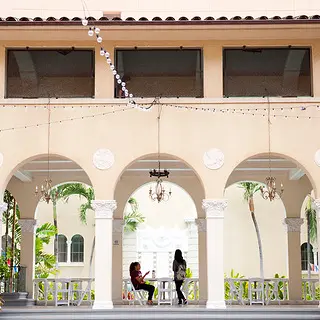
Why Julia Morgan's YWCA Oahu Is More Than Just a Building
When YWCA Oahu’s Honolulu headquarters were built in 1927, people were still getting used to the idea of women’s bathing suits that did not include full-length stockings. But the trailblazing California architect Julia Morgan probably didn’t care what swimmers were (or weren’t) wearing. If the women of the YWCA wanted a place to swim, she was going to design it for them.
Morgan was right in the middle of her long-term work for William Randolph Hearst on Hearst Castle, but the YWCA was one of her favorite clients. (Cities with Julia Morgan-designed YWCA buildings include Salt Lake City; Oakland, California; and San Francisco, among others.) She said yes to the job, and applied her usual blend of intensive engineering and exquisitely personal design to the project, which is located across the street from the Iolani Palace, the former royal residence of Hawaii.

photo by: Geoff Miasnik
Details such as quoins, balustrades, and wrought-iron balconies give the YWCA's stucco facade a formal elegance.
She created a regionally influenced space, with a large courtyard and a poolside loggia to capture the ocean breeze. Decorative ironwork and teak doors carved with images of native flowers soften the imposing front elevation, and in the courtyard, details such as arched openings, balustrades, and pilasters reveal Morgan’s rigorous Beaux-Arts training.
The idea was for it to feel like a country place amid the bustle of the city, and according to Noriko Namiki, CEO of YWCA Oahu, it does. “Once you walk into this building, the pace changes,” she says. “You take a deep breath. You can always feel the trade winds—it’s a nice oasis in downtown.”

photo by: Elyse Butler
Morgan created covered spaces throughout the building that look out over the central swimming pool.
YWCA Oahu has served thousands of women through its Dress for Success program, business leadership and job readiness courses, and exercise classes and facilities—including, of course, the central, open-air swimming pool. The three-story building is also known as Laniakea, which means “open skies” or “wide horizons” in Hawaiian.
The Historic Hawaii Foundation has helped the YWCA maintain the 90-year-old structure, providing funding for the restoration of the windows. The Y takes its stewardship of Laniakea seriously; in its view, the architecture and the organization’s mission are intertwined. Morgan was interested in empowering women, and this project was literally a concrete way of doing so.

photo by: Elyse Butler
The loggia is a favorite spot for both employees and visitors to relax and enjoy the tropical breezes that waft through the building.
“Laniakea is not just a building,” Namiki says. “It really represents our mission. Julia Morgan knew our mission and supported our mission and designed a building specifically for our mission.”
For the 30-person YWCA staff, she adds, Morgan is a presence they feel every day. “She wanted something simple—not too extravagant,” she says. “But something beautiful that makes you feel special. That affects our work with Dress for Success, and our other programs. People just love coming here.”
For more on pools by Julia Morgan (and others) check out our story on six historic swimming pools.


.webp)
